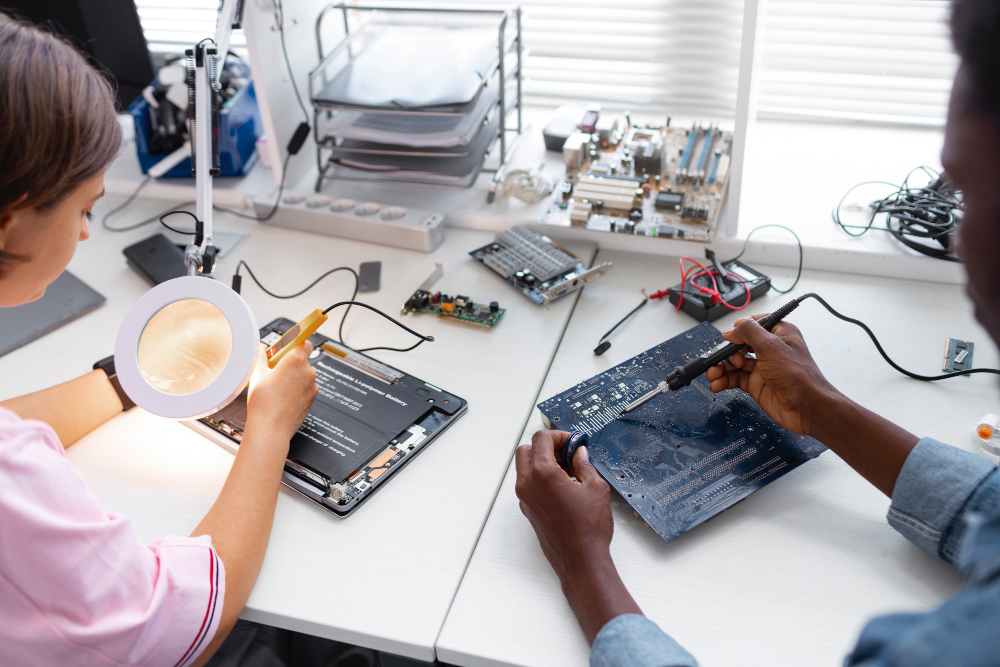In the digital age, we celebrate the software innovators, the app developers, and the social media gurus. But behind every click, every stream, and every algorithm lies a physical heart: the computer hardware that makes it all possible. For marketers and business leaders in the tech space, understanding the physical limitations and breakthroughs of this hardware is key to anticipating the next wave of digital innovation.
The relentless drive for smaller, faster, and more powerful devices places immense pressure on the manufacturing world. Creating the intricate components inside servers, laptops, and smartphones is a feat of engineering that often goes unnoticed. This article explores the critical technical challenges in producing this hardware and the advanced machining solutions that make our digital world tick.
The Confluence of Miniaturization and Material Science
The overarching trend in electronics is miniaturization. Moore’s Law, while slowing, continues to push for more transistors in the same space. This creates a domino effect on the physical components that house and support these microchips.
Key Technical Challenges:
- Micro-Scale Tolerances: Components like heat sink bases, connector pins, and sensor housings now require tolerances in the micron range (±0.0002 inches or less). A deviation thinner than a human hair can cause poor electrical contact, inadequate heat dissipation, or mechanical failure.
- Exotic and Difficult-to-Machine Materials: Aluminum and standard steel are no longer sufficient. Effective heat dissipation demands materials like copper alloys and beryllium copper, which are gummy and challenging to machine without burrs. High-strength applications use titanium or Inconel, known for their toughness and wear resistance on cutting tools.
- Intricate, Multi-Axis Geometries: Modern components are not simple blocks. They feature complex 3D contours, undercuts, and internal channels that are impossible to produce with traditional machining. This is especially true for components that must fit into increasingly compact and ergonomic devices.
- Surface Finish Imperatives: For an electrical contacts manufacturer, the surface finish is not just about aesthetics; it’s about performance. A rough surface increases electrical resistance, leading to heat buildup and signal degradation. A mirror-like finish is often a functional requirement.
Overcoming Challenges with Contract CNC Machining and Swiss Precision
This is where specialized manufacturing expertise becomes non-negotiable. Most electronics OEMs (Original Equipment Manufacturers) do not possess this level of machining capability in-house. They turn to a specialized contract CNC machining partner to bridge the gap between design and mass production.
A proficient contract manufacturer brings two powerful arsenals to the table: 5-Axis CNC Machining and Swiss-Type Machining.
5-Axis CNC Machining allows a cutting tool to approach a part from five different directions simultaneously. This is indispensable for complex geometries found in components like:
- Server Enclosures: With integrated cooling channels and mounting points at complex angles.
- Drone Motor Housings: Requiring lightweight but structurally sound designs with intricate shapes.
Swiss-Type Machining, originally developed for the watchmaking industry, is the secret weapon for ultra-precise, small-scale components. Its unique guide bushing system provides unparalleled stability, allowing for the production of exceptionally delicate and long, slender parts with stunning accuracy. The reliability of many electronic devices hinges on these precision Swiss machining products, such as:
- Connector Pins and Sockets: The tiny, gold-plated pins in your USB-C port or server backplane.
- Shielding Components: Precise, miniature parts that protect sensitive circuitry from electromagnetic interference (EMI).
A Deep Dive: The Critical Role of Electrical Contacts
Let’s zoom in on a component that is fundamental to every electronic device: the electrical contact. Whether it’s a blade server in a data center or a smartwatch on your wrist, electrical contacts are the lifelines of signal and power transmission.
The role of a proficient electrical contacts manufacturer extends beyond simple part production. It involves solving a multi-faceted problem:
- Material Selection: Choosing the right alloy (often phosphor bronze or beryllium copper) for the perfect balance of spring properties, conductivity, and machinability.
- Geometry for Reliability: Designing contact shapes that provide sufficient normal force for a stable connection over thousands of mating cycles, without succumbing to fatigue.
- Precision for Low Resistance: Machining the contact surfaces to a flawless finish to ensure minimal electrical resistance, which is critical for energy efficiency and signal integrity in high-frequency applications.
Failures here lead to data corruption, power loss, and device malfunction. The expertise required to produce these components reliably at scale is a core competency of advanced contract CNC machining providers who specialize in the electronics sector.
Case in Point: Enabling Next-Generation Technology
Consider the development of a new solid-state drive (SSD). The controller and NAND chips are the brains, but they require a precisely machined housing to manage the immense heat they generate. A poorly machined heat spreader can lead to thermal throttling, crippling the drive’s advertised speed.
Similarly, the rise of 5G infrastructure depends on radio frequency (RF) components like waveguides and filters. These parts have intricate internal channels that must be machined with extreme precision to guide high-frequency signals without loss. This is a task perfectly suited for advanced multi-axis CNC systems, handled by a expert contract CNC machining partner.
Conclusion: Hardware as the Foundation of Digital Growth
For the marketing and business leaders reading this, the takeaway is clear: the physical world of manufacturing is the bedrock upon which the digital world is built. The challenges of miniaturization, material science, and extreme precision are being met every day by advanced machining technologies.
The next time you launch a high-performance computing product, a new IoT device, or a marketing campaign that relies on robust data centers, remember the unseen precision inside. The collaboration between electronic designers and specialized manufacturers—those producing critical swiss machining products and acting as a reliable electrical contacts manufacturer—is what truly powers the hardware revolution, and in turn, your digital success.
 seolounge
seolounge